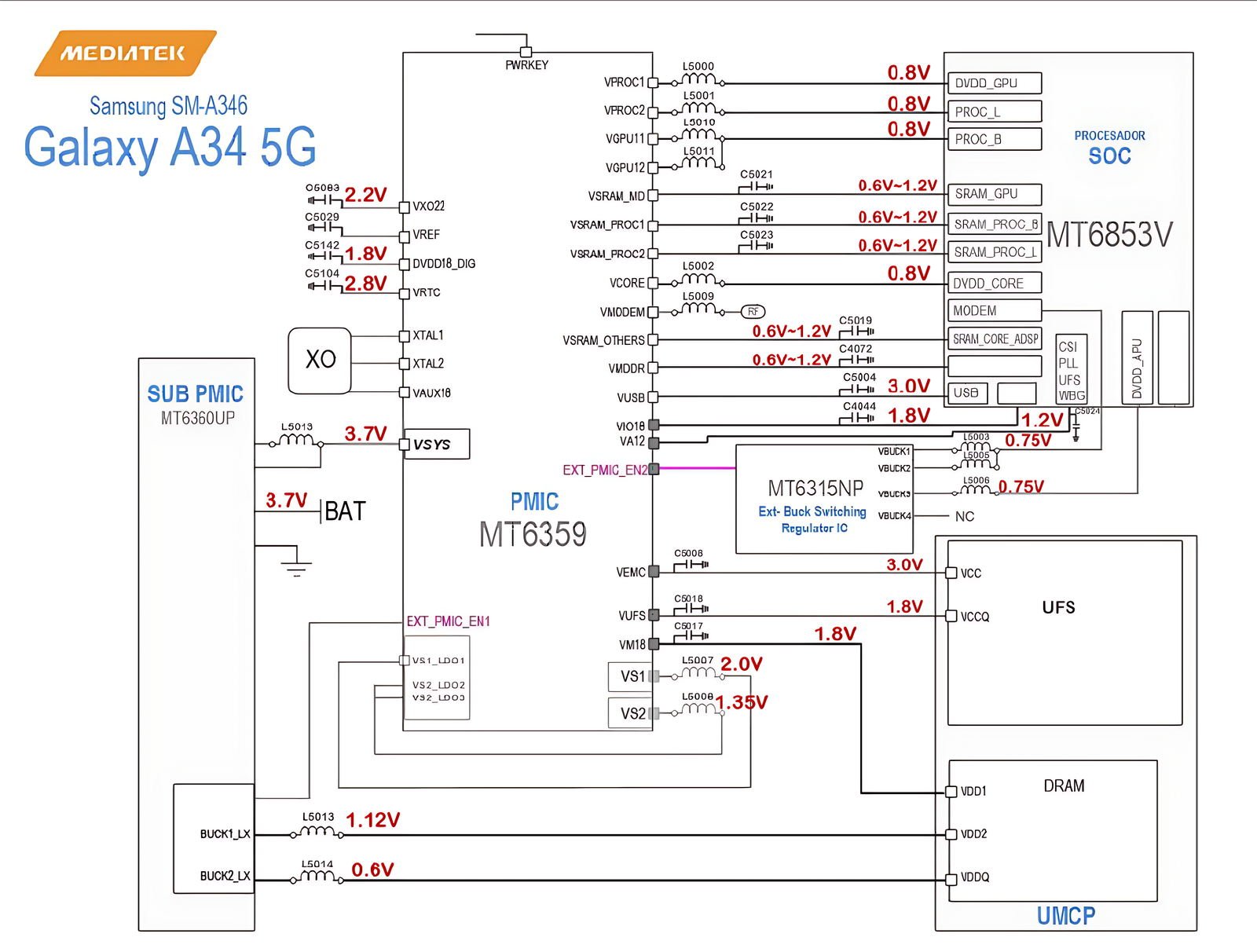Samsung SM-A346 5G MT6359 Power Management System
Introduction
Samsung Galaxy A34 5G (model SM-A346) is one of the most popular smartphones in the affordable 5G category. It offers impressive performance, long-lasting battery life, and modern features like a high refresh rate display and powerful cameras. A key component that contributes to the phone's efficient performance is its power management system.
At the heart of the power management system is the MT6359 PMIC (Power Management Integrated Circuit) from MediaTek. This chip is responsible for regulating and distributing the power supply to various components of the phone. In this article, we will explore the MT6359's design, its role in power distribution, and how it optimizes the device’s overall performance.

The Importance of Power Management in Smartphones
Power management is an essential aspect of modern smartphones. As devices become more powerful, they require efficient power management to balance performance with battery life. Each component inside a smartphone—whether it's the processor, memory, display, or storage—has specific power needs. A power management system ensures that the right amount of voltage is supplied to each part, which helps optimize performance and conserve energy.
The MT6359 PMIC plays a crucial role in this process. It ensures that the device receives a steady power supply while keeping energy consumption to a minimum. By intelligently distributing power to different components based on their needs, it helps maintain both the device's performance and battery efficiency.
Understanding the MT6359 PMIC
The MT6359 is an advanced power management chip from MediaTek, designed to efficiently manage power distribution within smartphones. It features several voltage regulators and low dropout regulators (LDOs) that are responsible for ensuring each component receives the required voltage.
Voltage Regulators: Voltage regulators convert the input power (from the battery) into various levels of output voltage needed by different components. The MT6359 manages multiple voltage rails, including 1.8V, 1.2V, and 0.75V, ensuring that each component gets the correct amount of power.
Low Dropout Regulators (LDOs): These are used to provide a stable voltage supply to sensitive components, like the modem and camera sensors, even when there are minor fluctuations in the input voltage.
How the MT6359 Works
The MT6359 takes the 3.7V battery voltage and distributes it to different components using various voltage rails. The schematic of the power management system shows that the PMIC controls power to major parts of the phone, including the processor (SoC), memory, display, and storage (UFS).
The primary voltage rail is **VSYS**, which supplies power to the system. From this, the PMIC generates lower voltages for different parts of the device. For example, the **1.8V rail** powers the core logic, including the SoC and UFS storage, while the **1.2V rail** is used for the processor and GPU. The **0.75V rail** powers the SRAM, helping in data processing with lower power consumption.
“Power management isn’t just about keeping the device running—it’s about ensuring every component has exactly what it needs, when it needs it.”
Voltage Rails and Their Importance
In the schematic, you can see that the MT6359 manages multiple voltage rails that are responsible for powering different parts of the device. Each voltage rail serves a specific purpose:
- 1.8V (VCC, VCCQ): This rail powers the core components, including memory and UFS storage, ensuring fast read and write speeds.
- 1.2V (VDD, VDD2): This voltage rail is crucial for the processor and GPU, providing them with the required power to run high-performance tasks like gaming or video editing.
- 0.75V (VSRAM): This rail powers SRAM, which is used for faster access to data, especially when the phone is running multiple apps or processing complex tasks.
- 2.0V and 3.0V (UFS, DRAM): These higher voltage rails are used to power UFS storage and DRAM, providing fast and efficient performance during multitasking and data-heavy operations.
The power management system intelligently adjusts the voltage supplied to each of these components, based on the workload. For instance, when the phone is idle, lower voltages are supplied to non-essential components, saving battery. Conversely, when gaming or multitasking, the necessary power is provided to maintain performance.
Efficient Power Conversion with Buck Converters
The MT6359 also includes several buck converters, which are a type of DC-DC converter designed to step down the voltage efficiently. These converters are vital for reducing power loss during the conversion process, thereby improving the overall efficiency of the phone's power management system.
For example, the **BUCK1_LX** and **BUCK2_LX** in the schematic are responsible for converting the battery voltage (3.7V) to 1.12V and 0.6V, respectively. This helps maintain stable power levels for components like the SoC and GPU, without draining the battery excessively.
Power Efficiency and Extended Battery Life
One of the most important aspects of the MT6359 PMIC is its efficiency. Power efficiency is crucial in smartphones because users expect their devices to last longer on a single charge. The MT6359 achieves this by providing power to components based on real-time demand.
During light usage, such as browsing or texting, the PMIC reduces power to non-essential components, keeping the overall energy consumption low. On the other hand, during heavy tasks like gaming or video streaming, the PMIC ensures that the necessary components, such as the GPU and processor, receive enough power to maintain high performance.
Conclusion
In conclusion, the MT6359 PMIC plays a crucial role in managing the power distribution within the Samsung Galaxy A34 5G. By efficiently distributing power to various components, it helps maintain a balance between performance and battery efficiency, ensuring that the phone can handle even the most demanding tasks without compromising on battery life.
As smartphones continue to advance, power management systems like the MT6359 will only become more important. The MT6359 ensures that every component, from the processor to memory, is powered efficiently, making it an essential part of the Galaxy A34’s overall design.
